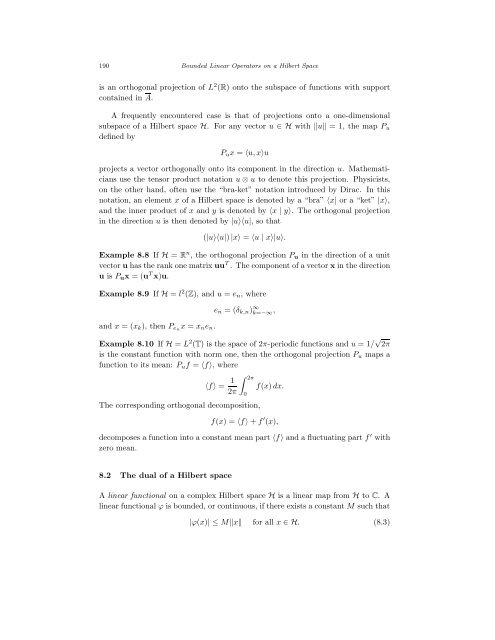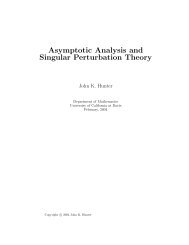Bounded Linear Operators on a Hilbert Space
Bounded Linear Operators on a Hilbert Space
Bounded Linear Operators on a Hilbert Space
You also want an ePaper? Increase the reach of your titles
YUMPU automatically turns print PDFs into web optimized ePapers that Google loves.
190 <str<strong>on</strong>g>Bounded</str<strong>on</strong>g> <str<strong>on</strong>g>Linear</str<strong>on</strong>g> <str<strong>on</strong>g>Operators</str<strong>on</strong>g> <strong>on</strong> a <strong>Hilbert</strong> <strong>Space</strong><br />
is an orthog<strong>on</strong>al projecti<strong>on</strong> of L 2 (R) <strong>on</strong>to the subspace of functi<strong>on</strong>s with support<br />
c<strong>on</strong>tained in A.<br />
A frequently encountered case is that of projecti<strong>on</strong>s <strong>on</strong>to a <strong>on</strong>e-dimensi<strong>on</strong>al<br />
subspace of a <strong>Hilbert</strong> space H. For any vector u ∈ H with u = 1, the map Pu<br />
defined by<br />
Pux = 〈u, x〉u<br />
projects a vector orthog<strong>on</strong>ally <strong>on</strong>to its comp<strong>on</strong>ent in the directi<strong>on</strong> u. Mathematicians<br />
use the tensor product notati<strong>on</strong> u ⊗ u to denote this projecti<strong>on</strong>. Physicists,<br />
<strong>on</strong> the other hand, often use the “bra-ket” notati<strong>on</strong> introduced by Dirac. In this<br />
notati<strong>on</strong>, an element x of a <strong>Hilbert</strong> space is denoted by a “bra” 〈x| or a “ket” |x〉,<br />
and the inner product of x and y is denoted by 〈x | y〉. The orthog<strong>on</strong>al projecti<strong>on</strong><br />
in the directi<strong>on</strong> u is then denoted by |u〉〈u|, so that<br />
(|u〉〈u|) |x〉 = 〈u | x〉|u〉.<br />
Example 8.8 If H = R n , the orthog<strong>on</strong>al projecti<strong>on</strong> Pu in the directi<strong>on</strong> of a unit<br />
vector u has the rank <strong>on</strong>e matrix uu T . The comp<strong>on</strong>ent of a vector x in the directi<strong>on</strong><br />
u is Pux = (u T x)u.<br />
Example 8.9 If H = l 2 (Z), and u = en, where<br />
and x = (xk), then Penx = xnen.<br />
en = (δk,n) ∞ k=−∞,<br />
Example 8.10 If H = L2 (T) is the space of 2π-periodic functi<strong>on</strong>s and u = 1/ √ 2π<br />
is the c<strong>on</strong>stant functi<strong>on</strong> with norm <strong>on</strong>e, then the orthog<strong>on</strong>al projecti<strong>on</strong> Pu maps a<br />
functi<strong>on</strong> to its mean: Puf = 〈f〉, where<br />
〈f〉 = 1<br />
2π<br />
2π<br />
The corresp<strong>on</strong>ding orthog<strong>on</strong>al decompositi<strong>on</strong>,<br />
0<br />
f(x) dx.<br />
f(x) = 〈f〉 + f ′ (x),<br />
decomposes a functi<strong>on</strong> into a c<strong>on</strong>stant mean part 〈f〉 and a fluctuating part f ′ with<br />
zero mean.<br />
8.2 The dual of a <strong>Hilbert</strong> space<br />
A linear functi<strong>on</strong>al <strong>on</strong> a complex <strong>Hilbert</strong> space H is a linear map from H to C. A<br />
linear functi<strong>on</strong>al ϕ is bounded, or c<strong>on</strong>tinuous, if there exists a c<strong>on</strong>stant M such that<br />
|ϕ(x)| ≤ Mx for all x ∈ H. (8.3)
















